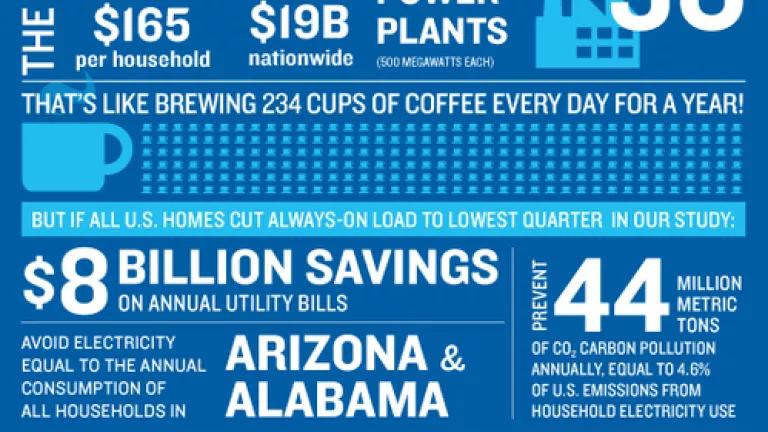Always-On Devices May Cost Americans $19 Billion Annually When We're Not Actively Using Them

As much as $19 billion worth of electricity may be wasted in U.S. homes by devices when they're not being actively being used. This represents 150 billion kilowatt-hours of electricity annually, enough electricity to power all the homes in Arizona and Alabama for one year - and equal to the output of 50 large power plants. These are among the striking findings of our NRDC study into household "idle load" energy use released today.
Our report, Home Idle Load: Devices Wasting Huge Amounts of Electricity When Not in Active Use, shows idle load accounts for nearly 23 percent of all electricity consumed in California homes. Nationally, this ratio may be lower because total power consumption is higher, but the amount of electricity wasted in idle is likely similar, because Americans everywhere generally purchase the same types of appliances.
Our study, conducted in partnership with Home Energy Analytics and the Stanford Sustainable Systems Lab, found that always-on devices are costing every household between $165 at the average national rate up to $440 a year at some utilities' top-tier rates, while giving their owners little real benefit.
The details
The study analyzed utility meter data from more than 70,000 homes in northern California to estimate the average idle load of homes, and a subset of 2,750 Bay Area homes to analyze how it varied by region, home size, home age, and number of occupants. We then performed a detailed audit of 10 homes to identify what types of devices were responsible for this idle load.
What did we learn? Appliances with digital displays, electronic controls and sometimes even 24/7 Internet connectivity—and devices that draw power even when not doing anything such as always-on heated towel racks and many audio/video devices--are all contributing to a massive hemorrhage of electricity.
Is everyone in the same situation?
No. Our study found that idle load varied by a factor of 1 to 6 between homes of similar size. In fact, if all homes in the United States were able to reduce their always-on consumption to the level of the 25 percent most efficient households in our California survey, we could:
- Save $8 billion on our annual household utility bills;
- Avoid 64 billion kilowatt hours of electricity use a year; and
- Prevent 44 million metric tons of carbon dioxide pollution.
So how is it done?
The good news is that this is a problem that is well within our reach to solve. In energy-saving terms, this is a piece "low-hanging fruit." We're not calling for massive technological innovations here. The capacity to fix this problem is already within our grasp.
By making a few simple changes—to individual behavior, to manufacturer designs, to utility company efficiency programs, to energy standards (such as setting maximum levels of standby power across many devices)—we could minimize idle load and save a huge amount of energy.
Consumer action
First, let's take consumer action. The average home in our field survey had 65 devices using electricity. Identifying those with the highest "always-on" load is a good first step to know where to focus your efforts. You can take your own "idle load" survey of your home by downloading step-by-step directions here. Unplugging devices that are rarely used, making better use of power strips and timers so that devices only draw power when you need them, and adjusting electronic devices to automatically power down to the lowest power mode when not in use should substantially reduce your idle load.
Manufacturer action
While consumer action can bring individual benefits in terms of lower bills, realistically only a few people will bother. For energy savings to scale up and result in shutting down power plants and avoiding the harmful pollution they produce while generating electricity, manufacturers must step up, too, by designing products that minimize idle power consumption.
Utility action
We also call upon utilities and their regulators to ramp up energy-saving programs: If every electricity bill came with an indication of what a household could save with smarter use of appliances and electronic devices, we'd soon see our meters slowing down. Utilities can also incentivize the use of innovative home energy management solutions now offered by an increasing array of companies.
Public policy action
Voluntary action is useful but only goes so far. Public policy is necessary to create the conditions for large-scale consumer, manufacturer and utility action. Lawmakers and government agencies need to step in to ensure significant public benefits are achieved.
Requiring manufacturers to disclose idle load energy use on product labeling is a good place to start; a timely reminder of how our choices at the store affect our energy bills at home. Our study found that idle load varies widely depending on device models. For example, the idle electricity use of printers ranged from 2 to 26 watts per home. Our study cites many additional examples here. A label along the lines of "This product consumes 10 watts in standby which may cost you $50 to $130 in electricity over five years," might either help consumers choose a more efficient product, or encourage them to switch it off when not in use.
Ultimately, all devices should be required to meet a maximum efficiency standard limiting their idle load electricity use. Much as we have the right to expect that our food is safe to eat and our cars are safe to drive, we should be able to expect that the electric devices we buy are efficient and environmentally sound to use, without having to worry about it or do complicated research to avoid idle energy guzzlers. Our policymakers have the power to set these standards and make idle load a problem of the past. It is time for them to take action!
